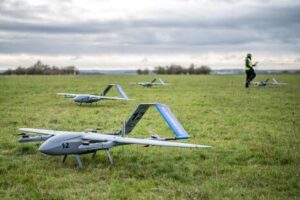The three AUKUS partner countries recently tested artificial drone intelligence (AI) and autonomy systems in a swarm setting as part of the non-submarine parts of the tripartite collaboration.
The U.K. hosted a demonstration at Upavon in Wiltshire, U.K. on April 28 with contributions by the U.S. and Australia governments to test the first AI/autonomy trial of its kind, with their assets acting in a “collaborative swarm to detect and track military targets in a representative environment in real time,” the U.S. Defense Department and U.K. Defense Ministry said on May 26.

The U.K. Defence Ministry noted this trial included the live retraining of models in flight and interchange of AI models among the three nations. It included various air and ground vehicles including the Blue Bear Ghost (UK) and Insitu [BA] CT220 (AUS) uncrewed aerial vehicles (UAVs), BAE Systems Challenger 2 tank, Warrior armored vehicle and Horiba Mira Viking uncrewed ground vehicle (UGV), along with a commercially hired FV433 Abbot self-propelled gun and former Eastern Bloc BMP OT-90 infantry fighting vehicle.
Cooperation on AI and autonomy is part of the Advanced Capabilities of Pillar II of the AUKUS agreement that primarily aims to have the U.S. and U.K. help Australia procure nuclear-powered attack submarines to ultimately succeed its current conventionally-powered Collins-class submarines.
Pillar II specifically plans to accelerate collaboration of AI and autonomy technologies to more rapidly field trustworthy AI and autonomy for complex operations while also adhering to shared values of responsible AI systems.
The countries underscored this was the first time Australia, U.K. and U.S. used a jointly developed AI capability deployed on coalition autonomy systems to conduct Intelligence, Surveillance, and Reconnaissance (ISR) missions.
The event was organized by the U.K. Defence Science and Technology Laboratory (DSTL). It completed the first live collaborative retraining of models in flight and the interchange of AI models among AUKUS nations.
“We recognize the immense importance of this collaboration in strengthening our combined national security of our nations. The development and deployment of advanced artificial intelligence technologies have the potential to transform the way we approach defense and security challenges. This capability demonstration is truly a shared effort, and is a critical step in our trilateral initiative to stay ahead of emerging threats,” Abe Denmark, senior AUKUS adviser to the U.S. Secretary of Defense, said in a statement.
Denmark noted the countries are starting to pool their expertise and resources so they can all access the best AI, reduce duplication of effort and enable interoperability.
“We are pooling our expertise and resources through our AUKUS partnerships, ensuring that our militaries are equipped with the latest and most effective tools to defend our nations and uphold stability around the world,” he said.
“Accelerating technological advances will deliver the operational advantages necessary to defeat current and future threats across the battlespace,” U.K. Gen. Rob Magowan, deputy chief of the defense staff (financial and military capability), added.
Hugh Jeffrey, Australian deputy secretary for strategy, policy and industry, argued an eventual mission-tailored adaptive AI will “deliver a capability greater than what any country can do alone. That really is the rationale for AUKUS.”
“I was impressed to see AI models rapidly updated at the tactical edge to incorporate new targets, which were immediately shared among the three partners to deliver decision advantage and meet changing mission requirements,” Jeffrey said.